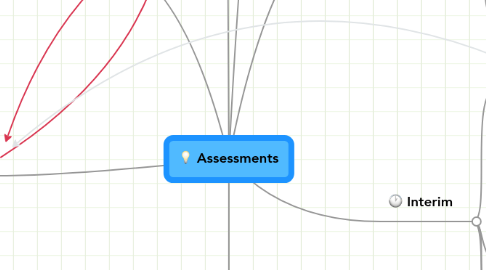Assessments
Door Tracy Bell


1. Formative
1.1. Description: Formative assessments serve as a method of assessing a student's current functioning. Provides feedback to the teacher on the information students have mastered or what areas need to be reviewed further.
1.2. Purpose: To provide feedback on how students are responding to instruction. Allows teachers to adjust teaching by moving on in the curriculum or reviewing aspects further. Formative assessments can serve as a diagnostic assessment to provide further insight into why a student is struggling.
1.3. Examples: Exit tickets, "quizzes", whiteboards, think-pair-share, journaling.
1.4. What does it measure? Goals, objectives, material covered, lesson content, and standards.
2. Summative
2.1. Description: Summative assessments assess a student's achievement and growth at the end of the year, semester, or course.
2.2. Purpose: Determines what a student has learned.
2.3. Measures: Long term goals, content covered in a course, or grade-level objectives.
2.4. Example: Unit tests, benchmark tests, course exams.
3. Diagnostic
3.1. Description: Diagnostic assessments are administered to students to give teachers a closer look into student performance. Multiple diagnostic assessments can be used to triangulate data and help pinpoint specific areas.
3.2. Purpose: Assessments are administered to students that are identified from screening assessments to give teachers an idea of a student's specific areas of need. Information is used to plan, modify, or differentiate instruction.
3.3. Examples: Fontas & Pinell, Running Records, and Qualitative Reading Inventory (QRI)
3.4. Measures: Specific literacy skills; comprehension, phonemic awareness, vocabulary, decoding.
4. Monitoring
4.1. Description: Monitoring assessments track a student's progress to determine if a student is on track. Progresses towards end of the year goals and objectives.
4.2. Purpose: Monitoring assessments are typically used to monitor progress of students that are at-risk and/or receiving special services and interventions.
4.3. Measures: Student progress, student response to instruction/intervention.
4.4. Examples: AIMSweb, Oral Reading Fluency (ORF), Curriculum-Based Measures
5. Interim
5.1. Description: Interim assessments are administered at different times (intervals). They can be evaluative, predictive, or diagnostic.
5.2. Purpose: Interim assessments serve various purposes all of which is to provide instructional information. An interim assessment can measure student achievement over a period of time, can display trends and patterns among a group of students, can show how students are progressing and/or responding to interventions. This type of assessment can also be used to indicate progress towards milestones or predict outcomes.
5.3. Example: Grade-level benchmark tests.
5.4. Measures short and long-term goals. Mastery and understanding of content covered over a period of time.
6. Screening
6.1. Description: Screening assessments are administered to a group of students, typically of the same grade level, to help teachers indicate students that are struggling and may need extra help.
6.2. Purpose: To identify students that are at-risk or struggling and may require additional services or supports.
6.2.1. Identifies at-risk students
6.2.2. Can display gaps in learning to drive instruction.

